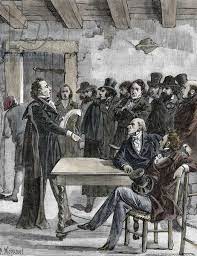Before I continue with the speech of the Catholic attorney and widely-acclaimed Catholic writer author and lecturer for the past 20 years and former high-rank freemason John Salza, I would like to stop for a while so to give some information to you about The Carbonari. Dr Salza mentioned the Carbonari in his speech and how “Our Lady’s warnings at Quito were confirmed by Pope Gregory the XVI in the 19thcentury when he discovered a document that is often known as the Permanent Instruction of the Alta Venditawritten by a member of The Carbonari. And this was a blueprint for subverting the Catholic Church by infiltrating it with liberal ideas in effect to have a masonic revolution in the church.”Thus there were elements within the Carbonari who wanted to infiltrate the Church with their liberal ideas. I will also publish the Alta Venditain a separate series of blogs. In the Alta Vendita the Carbonari mentioned the role that freemasonry will have in the world up to this day.
Who were the Carbonari?
The Carbonari was an informal network of secret revolutionary societies active in Italy from about 1800 to 1831. The Italian Carbonari may have further influenced other revolutionary groups in France Portugal Spain Brazil Uruguay and Russia[1].
“The Carbonari were a secret societydivided into small covert cellsscattered across Italy. Although agendas varied evidence suggests that despite regional variations most of them agreed upon the creation of a liberal unified Italy”.[2]
The Carbonari were anti-clerical in both their philosophy and programme.The papal constitution Ecclesiam a Jesu Christoand the encyclical Qui pluribuswere directed against them. The controversial document Alta Vendita which called for a liberal or modernist takeover of the Catholic Church was attributed to the Sicilian Carbonari[3].”
Although it is unclear where they originated[4] they rose to prominence during the Napoleonic Wars in the Kingdom of Naples. Although some of the society’s documents claimed that it originated in medieval France and that its forefathers were sponsored by Francis I of France during the sixteenth century this claim has not been independently verified. Although many theories have been advanced regarding the origins of the Carbonari the organization arose as an offshoot of Freemasonry [5] as part of the spread of liberal ideas from the French Revolution. In any case the power of the association was first demonstrated at the beginning of the nineteenth century in the Kingdom of Naples (under Joachim Murat’s control) and the Papal States.
The Carbonari operated largely in secret as a secret societythat was frequently targeted for repression by conservative governments. The name Carbonari identified the members as rural “charcoal-burners”; just as the name “Carbonari” was derived from charcoal-burners so many expressions derived from the occupation of charcoal-burning were used in their secret communication. The gathering place was called baracca (hut) its interior vendita (coal selling place) and its surroundings foresta (forest). Members referred to one another as buon cugino(good cousins) while those who did not belong to the society were referred to as pagani (heathens).
[1]Galt Anthony (December 1994) “The Good Cousins’ Domain of Belonging: Tropes in Southern Italian Secret Society Symbol and Ritual 1810-1821” Man New Series vol. 29 Wiley Royal Anthropological Institute of Great Britain and Ireland pp. 785–807 doi:10.2307/3033969 JSTOR3033969
[2]Smith Denis Mack (1988) [1958] The Making of Italy
[3]“The Life of a Conspirator” The Rambler New Series I May 1854
[4]Kirsch Johann Peter (1908) “Carbonari“ in Herbermann Charles (ed.) Catholic Encyclopedia vol. 3 New York: Robert Appleton Company
[5]Rath John (January 1964) “The Carbonari: Their Origins Initiation Rites and Aims” The American Historical Review
69(2): 353–370 doi:10.2307/1844987 JSTOR1844987

